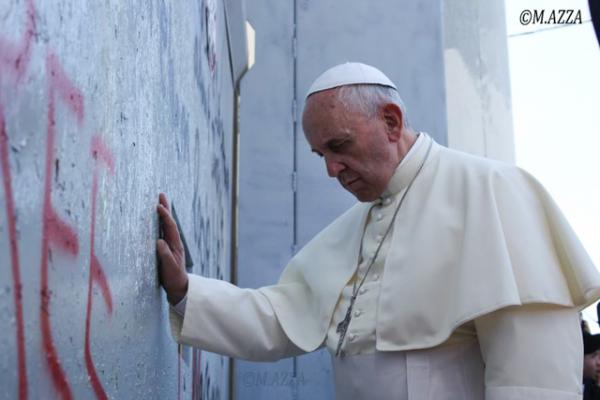Recently I had the privilege of attending the Mass led by Pope Francis in Bethlehem’s Manger Square. I am not a Catholic – but like many who are not, I have been inspired and touched by Pope Francis. I do not know what is it exactly that draws me to him! Is it his humility? His compassion for the poor? His social justice concern? His true ecumenical spirit ? Maybe all of the above!
Back to Manger Square. It was truly a special day. There were Palestinian Christians from all over Palestine and Israel. There was a sense of euphoria in the air. I have never seen Bethlehem like this before. I have never in my life witnessed Palestinian Christians with so much joy and jubilation. People were excited. Nuns were dancing in the streets. There were hymns, flags, smiles. For few hours we forgot we were occupied.
However, the most iconic moment during the Pope’s visit to Bethlehem did not take place in the Manger Square, nor the Nativity Church. It took place next to the Separation Wall.
For years I have seen pilgrims come to Bethlehem to visit the Nativity Church. I have always wondered: Do they care about the suffering of the Palestinians? Do they pay attention to the wall as they enter through the main checkpoint? Do they notice the refugee camp as they make their way to the church? Or are they mainly concerned about performing their religious duty? Or maybe the main thing is to satisfy their love of history by visiting this ancient site?
That is why, when Pope Francis stopped, touched the wall, and said a prayer – it was truly an iconic moment. Pope Francis couldn’t but notice the ugliness of this concrete structure at the heart of Bethlehem. This wall should make us all uncomfortable. The pope couldn’t but respond. By responding in this manner, the pope touched more than the wall. He touched the ugliness of the occupation and war. He touched the depth of our suffering. With humility and weakness, he looked injustice in the eyes, and challenged it.
Bethlehem Bible College runs a biannual conference called “Christ at the Checkpoint” in which we ask: “What would Jesus do if he is to stand in front of an Israeli checkpoint or the separation wall today?” We now know how Pope Francis reacted. He lamented. He lamented over the reality of the wall. He also prayed.
What did he say in his prayer? Truth is I don’t want to know. Some words are better left unspoken. The image of him standing next to the wall and praying will forever be carved in our memories. For me, this image is going everywhere. On my office wall, Facebook page, desktop wallpaper. For us as Palestinian Christians, this image is going deep into our memory. And when this wall falls one day (not if, but when), we might go back to this moment and this prayer as one of the key moments that led to its fall.
At the end of the day, the pope left, and the occupation and the wall remained. But we were left with a renewed sense of hope – knowing that we are not forgotten. We were left with a mandate to continue lamenting the current situation, to fight against injustice, and to pray.
Munther Isaac is the Vice Academic Dean at Bethlehem Bible College and a PhD candidate at the Oxford Center for Mission Studies. He is also the director of the Christ at the Checkpoint Conference.
Got something to say about what you're reading? We value your feedback!
